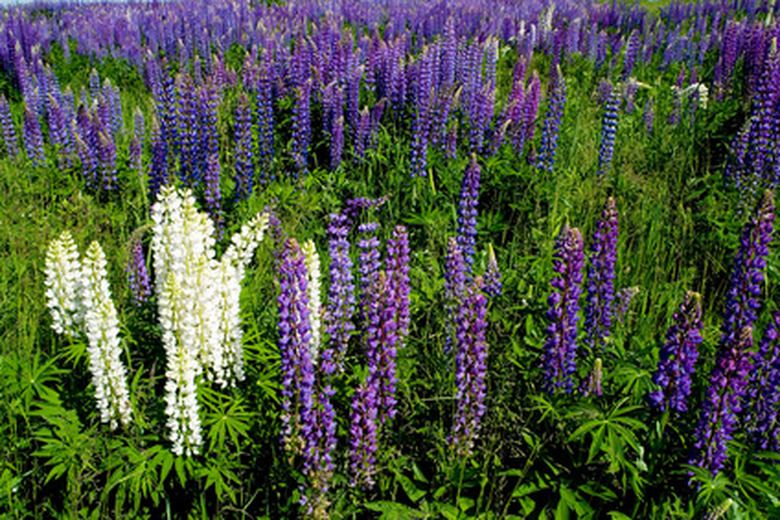Lupine Toxicity
Lupine plants may be beautiful to look at, but can be toxic to animals, even in small doses. Larger doses may result in a variety of symptoms or death, even if those larger doses are the result of accumulations over time. Lupine toxicity is of particular concern to individuals raising forage animals, such as sheep and cattle.
Identification
Lupine plants are perennial herbs, usually between 1 and 2 feet in height. They are considered legumes, plants in the bean family. Leaves feature 10 to 15 leaflets that alternate along a central stalk in small, palm-like fronds. Leaves may or may not have hair on top, but the undersides are always hairy. Flowers are most commonly blue, but may be shades of purple, red, yellow or white and grow in rounded, bell-like shapes along a single stalk. Seeds are borne in long pods, as with other legumes.
- Lupine plants may be beautiful to look at, but can be toxic to animals, even in small doses.
- Flowers are most commonly blue, but may be shades of purple, red, yellow or white and grow in rounded, bell-like shapes along a single stalk.
Types
While most members of the lupine family are poisonous, that is not true of all of them. According to the United States Department of Agriculture, is known that yellow lupine, silvery lupine, silky lupine, tailcup lupine, velvet lupine and lunara lupine are definitely poisonous.
Time Frame
Lupine toxicity changes over the lifetime of toxic varieties of the plant. They are most poisonous from germination until seed pods have shattered and dropped in late summer or early autumn. Seed pods are the most toxic part of these plants, although all parts are somewhat toxic. Toxic effects may be exhibited in poisoned forage animals anywhere between one hour to 24 hours after exposure.
Symptoms
Frothing at the mouth, excessive drool, skittishness, depression, convulsions, coma, and/or death are some of the symptoms that animals foraging on lupine may experience. Occasional ingestion of lupine in small amounts, even if it includes seed pods, may not affect these animals as long as it is limited. However, repeated exposure to small amounts (such as foraging in the same area and ingesting a single plant every day for multiple days) may still cause symptoms. Cows that ingest any of the six poisonous species of lupine between days 40 and 70 of calf gestation may birth calves that have crooked leg syndrome.
- While most members of the lupine family are poisonous, that is not true of all of them.
- However, repeated exposure to small amounts (such as foraging in the same area and ingesting a single plant every day for multiple days) may still cause symptoms.
Sheep can ingest up to 3 oz. of lupine without experiencing ill effects, notes the USDA. Cows do not experience ill effects unless they ingest more than 1 to 2 lbs. of lupine in total, including adding together small amounts ingested over a period of three to seven days.
Prevention/Solution
Areas with large amounts of lupine growing should be avoided by forage animals. If hay or other grasses are dried and baled in an area, care should be taken that lupine is not growing in the area. Lupine does not lose its toxicity upon being dried, and can cause symptoms in animals that eat affected hay or other dried grasses. Lupine may be treated with herbicidal chemicals, but care should be taken to ensure that forage animals are not exposed to dangerous chemicals when they are sent out to eat.
- Sheep can ingest up to 3 oz.
- Lupine does not lose its toxicity upon being dried, and can cause symptoms in animals that eat affected hay or other dried grasses.
